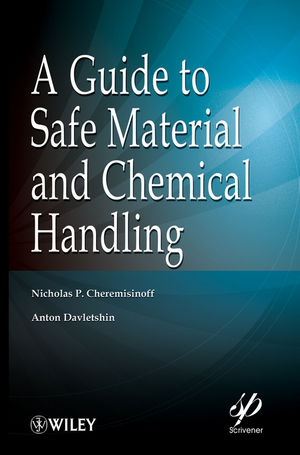A Guide to Safe Material and Chemical HandlingISBN: 978-0-470-62582-8
Hardcover
496 pages
March 2010
 |
||||||
Author Biographies.
List of Tables.
1. Corrosion.
1.1 General Information.
1.2 Types of Corrosion.
1.3 Materials Evaluation and Selection.
1.4 Corrosion Data.
2. Material Properties and Selection.
2.1 General Properties and Selection Criteria.
2.2 Cast Irons.
2.2.1 Gray Cast Iron.
2.2.2 White Cast Iron.
2.2.3 Malleable Cast Iron.
2.2.4 Nodular Cast Iron.
2.2.5 Austenitic Cast Iron.
2.2.6 Abrasion Resistance.
2.2.7 Corrosion Resistance.
2.2.8 Temperature Resistance.
2.2.9 Welding Cast Iron.
2.3 Steels.
2.3.1 Low Carbon Steels (Mild Steel).
2.3.2 Corrosion Resistance.
2.3.3 Heat Resistance.
2.3.4 Low Temperatures.
2.3.5 High-Carbon Steels.
2.3.6 Low-Carbon, Low-Alloy Steels.
2.3.7 Mechanical Properties.
2.3.8 Corrosion Resistance.
2.3.9 Oxidation Resistance and Creep Strength.
2.3.10 Low-Temperature Ductility.
2.3.11 High-Carbon, Low-Alloy Steels.
2.3.12 High-Alloy Steels.
2.3.12.1 Chromium Steels (400 Series), Low-Carbon Ferritic (Type 405).
2.3.12.2 Medium Carbon Martensitic.
2.3.12.3 Medium Carbon Ferrule.
2.3.12.4 Chromium/Nickel Austenitic Steels (300 Series).
2.3.13 Precipitation Hardening Stainless Steels.
2.4 Materials Properties Data Tables.
3. Property Tables of Various Liquids, Gases, and Fuels.
3.1 General Properties of Hydrocarbons.
3.1.1 General Information.
3.1.2 Isomers.
3.1.3 Alkenes.
3.1.4 Alkynes.
3.1.5 Straight-Chain Hydrocarbon Nomenclature.
3.1.6 Aromatic Hydrocarbons.
3.1.7 Hydrocarbon Derivatives.
3.1.8 Halogenated Hydrocarbons.
3.1.9 Alcohols.
3.1.10 Ethers.
3.1.11 Ketones.
3.1.12 Aldehydes.
3.1.13 Peroxides.
3.1.14 Esters.
3.1.15 Amines.
3.2 Fuel Properties.
3.2.1 Crude Oil.
3.2.2 Gasoline.
3.2.3 Bioethanol and ETBE.
3.2.4 Diesel Oil, Kerosene, Jet A1, and Biodiesel.
3.2.5 Fuel Oil.
3.2.6 Natural Gas, Biogas, LPG and Methane Hydrates.
3.2.7 Hydrogen.
4. General Guidelines on Fire Protection, Evacuation, First Responder, and Emergency Planning.
4.1 Flammability Properties.
4.1.1.1 General Information.
4.1.1.2 Flammability Designation.
4.1.2 Ignition Temperature.
4.1.3 Flammability Limits.
4.1.4 Vapor Density.
4.1.5 Specific Gravity.
4.1.6 Water Solubility.
4.1.7 Responding to Fires.
4.1.8 Firefighting Agents.
4.1.8.1 Water.
4.1.8.2 Foam.
4.1.8.3 Alcohol-Resistant Foams.
4.1.8.4 High Expansion Foams.
4.1.8.5 Other Extinguishing Agents.
4.1.8.6 Carbon Dioxide.
4.1.9 Electrical Fire Prevention.
4.1.10 Firefighting Guidance.
4.1.10.1 Types.
4.1.10.2 Firefighting Agents and Extinguishers.
4.1.10.3 Vehicles.
4.1.10.4 Firefighting Gear.
4.1.11 Specialized Rescue Procedures.
4.1.12 First Responder to Electrical Fire Incidents.
4.1.13 Evacuation Planning.
4.1.13.1 Designated Roles and Responsibilities.
4.1.13.2 Preparation & Planning for Emergencies.
4.1.14 Evacuation Procedure.
4.1.15 General.
4.1.16 Template for Emergency Evacuation Plan.
5. Chemical Data.
6. Chemical Safety Data.
7. Recommended Safe Levels of Exposure.
8. Fire and Chemical Reactivity Data.



